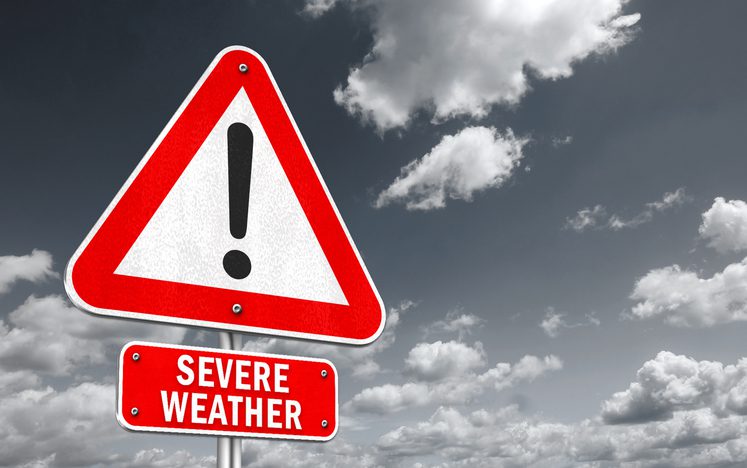After the blustering winds dwindle and the rain torrents turn into trickles, your first reaction will likely be a sigh of relief that the hurricane has passed. Hopefully, you prepared well for the storm. But remember that life won’t return to normal right away. Along with that, there are steps you need to take in the aftermath of the storm, which we’ve outlined below.
If you’re insured by The Hartford, visit our online claims center to file a claim. You’ll be contacted within one business day to assess your needs, answer your questions and provide service options. Our goal: to get your life back to normal as quickly as possible.
Staying Safe at Home
One of your first steps should be to let your family and friends know you are safe. This is particularly important if the power is out and phone service is down. If you have a smartphone that has access to the internet, you can use the American Red Cross’ Safe and Well site to post messages or use Facebook to mark yourself “safe.”
Whether you weathered the storm at home or are returning now that the storm has passed, there are some precautions you can take to help ensure you and your family stay safe.
If your power is out, turn off most of your light switches and unplug your appliances and electronics. These include your television, computer and printer. Leave one or two light switches on so that you’ll know when the power is restored. In the meantime, use flashlights, not candles, to avoid starting a fire.
Check your refrigerated food for spoilage. Typically, you should discard raw meat, eggs and dairy products after six hours without power. If you don’t know how long the power has been out or if you have any doubt about the freshness of a food item, it’s best to throw it out. Transfer any medications that need to be chilled, like insulin. You can transfer these to a cooler filled with ice or frozen water bottles.
Avoid drinking your tap water or preparing food or beverages with it until you know that the water supply is safe and not contaminated. If you must use the tap water, boil it for at least one minute. This helps make it safe for consumption, according to the Centers for Disease Control.
And don’t forget to take special care of your pets. They were probably shaken by the storm and may still be scared. Keep them close to you as much as possible.
Staying Safe Outside
If you were evacuated, you’re probably eager to rush home to check on your property’s condition. If you were sheltering in place, you’re probably itching to get outside. Either way, don’t give into the temptation until you’ve checked your local news, weather channels and emergency broadcasts to be certain it’s safe. Sometimes wind, rain and flooding continue after the storm has passed.
Even after you’ve been given the all-clear and it appears safe enough to head outside, you need to take safety precautions. Whether you’re on foot or in your car, keep your eyes out for:
- Flood Waters: Even just six inches of moving water can knock you down, and 12 inches can float your vehicle. In addition, water can obscure debris or a dangerous sink hole. And if fallen or underground power lines charge the water, you could be electrocuted.
- Debris: If you’re walking, be vigilant to avoid tripping over debris or being hit by a weakened branch that suddenly snaps off. If you’re driving, remember that broken branches, fallen trees and other objects that have been blown around during the storm can damage your car or cause an accident.
- Downed Power Lines: If you see any dangling power lines or downed electrical poles, report them to your local power company and keep your distance.
- Damaged Roads: Try to avoid roads and bridges that could have been weakened by the storm. News alerts and emergency broadcasts may not be up-to-date on every closed or dangerous road. If at all possible, avoid driving altogether, recommends the American Red Cross.
Post-Hurricane Recovery
If it’s safe to go outside, start checking your property for damage. Your most immediate need is to prevent further damage from occurring. If, for example, the roof is leaking, cover it with a tarp or other sturdy material. This helps to minimize damage to the interior of your home and your possessions. Or, if the storm weakened tree branches, call someone to have them removed before they fall. Note that if you don’t take steps to prevent further damage, your insurance may not cover that damage.
After you’ve seen to any areas that need immediate attention, carefully inspect your home—inside and out—and take photos of anything that’s been damaged. This includes your vehicle(s), personal possessions (e.g., clothing, furniture, outdoor grill, patio furniture), and landscaping. Photo capture allows the opportunity for customers to take and share pictures of their property damage from ground level, when safe to do so. Additionally, video and virtual walk through may be available. Your adjuster will advise you of what you need to complete the process.
Your inspection should also reveal areas that you need to clean up. This includes areas such as gutters and downspouts that are clogged with storm debris. Take photos before you clean up just in case you find related water damage later. Although you should address any issues that could lead to further damage, don’t start repairs until after you‘ve discussed the claim and repair process with your insurance company.
Filing an Insurance Claim
As soon as you’ve inspected your home and documented the issues you uncovered, contact your home insurance company to provide details about the incident and the damage.
Your insurance company will need you to explain what happened to your home (e.g., a tree fell on it during the hurricane), describe the damage to your property (e.g., there’s a hole in my roof), and provide a phone number where they can reach you throughout the claim process. If you can’t stay in your home because of the damage, find out whether your insurance will cover any of the costs to stay elsewhere.
Take steps to stay safe after the storm, document your home’s condition, and contact your insurer as soon as possible to start undoing the damage from the hurricane.







Thank you for this information. It was great!
Thanks greatly needed information, thank you very much!!